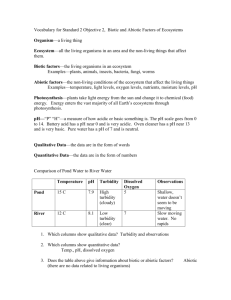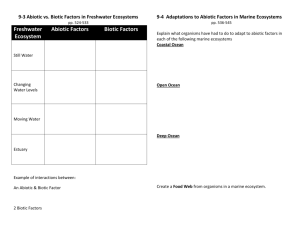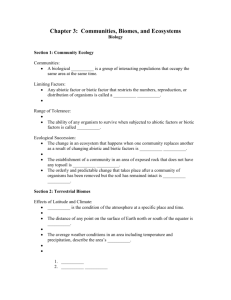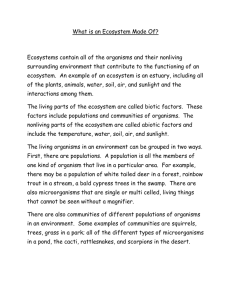Science 7 Abiotic and Biotic Environments
advertisement
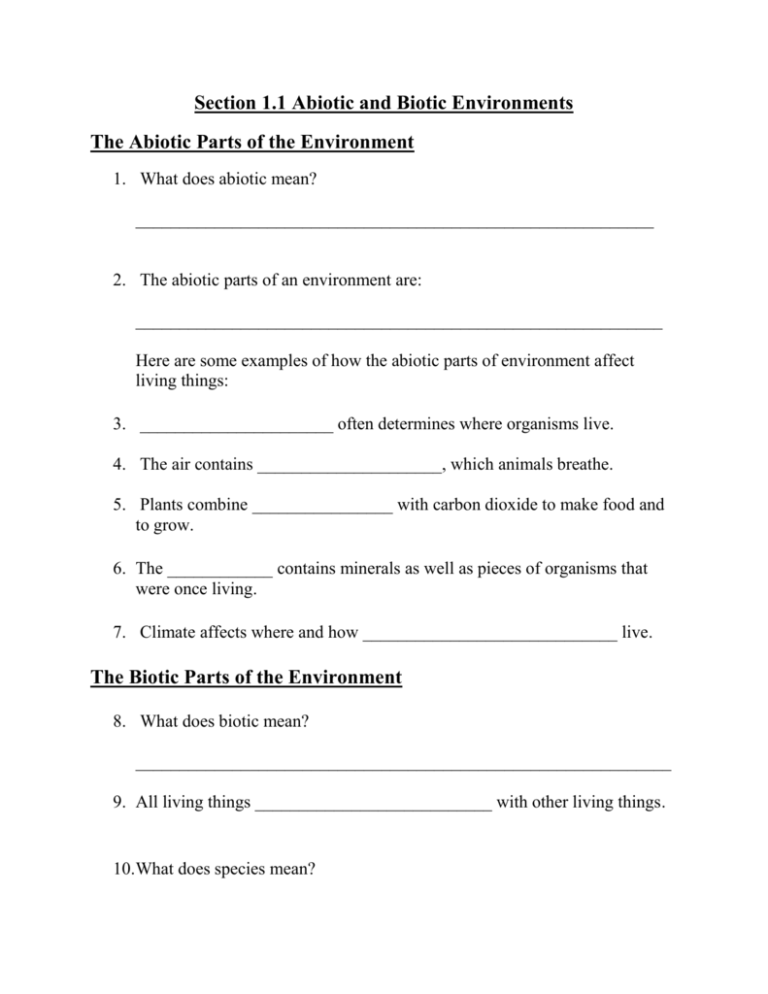
Section 1.1 Abiotic and Biotic Environments The Abiotic Parts of the Environment 1. What does abiotic mean? ___________________________________________________________ 2. The abiotic parts of an environment are: ____________________________________________________________ Here are some examples of how the abiotic parts of environment affect living things: 3. ______________________ often determines where organisms live. 4. The air contains _____________________, which animals breathe. 5. Plants combine ________________ with carbon dioxide to make food and to grow. 6. The ____________ contains minerals as well as pieces of organisms that were once living. 7. Climate affects where and how _____________________________ live. The Biotic Parts of the Environment 8. What does biotic mean? _____________________________________________________________ 9. All living things ___________________________ with other living things. 10.What does species mean? 11.Since you are a living thing, you are a ______________________ of the environment. 12.Think about the basic things that you need to stay alive. All living things need: _____________________________________________________ _____________________________________________________ _____________________________________________________ _____________________________________________________ 13.When you take a breath, put on a warm coat, wave to a friend, or avoid a buzzing bee, you are interacting with the ________________________ parts of your environment. 14.What are main differences between the abiotic parts and biotic parts of an environment? ____________________________________________________________ 15.What are the basic needs of plants? ____________________________________________________________ ____________________________________________________________ ____________________________________________________________ Interactions Between Abiotic and Biotic Parts of the Environment 16. What is ecology? ___________________________________________________________ Ecosystems 17. What is an ecosystem? ___________________________________________________________ 18.In the pond ecosystem in Figure 1.7, organisms eat other _______________, defend themselves, reproduce, and compete for food and space. 19. Its ________________ parts also affect the pond ecosystem. These _______________ parts might include the amount of sunlight and rain the pond receives, and the temperature of the air above it. 20.Using Figure 1.8, page 13, list the different interactions that are occurring in this ecosystem: __________________________________________________________________ __________________________________________________________________ __________________________________________________________________ __________________________________________________________________ __________________________________________________________________ Biomes 21.Many ecosystems have broadly similar ________________ and have similar ______________________________ every year. 22. Therefore, _____________________________ that are found in these ecosystems could be similar 23.What are biomes? ____________________________________________________________ 24.What are the four major biomes found in Canada? ____________________________________________________________ British Columbia’s Ecosystems 25.British Columbia has more ___________________________ than any other province in Canada. 26.Why does our province have such a variety of organisms? _________________________________________________________ 27.What is an ecoprovince? _________________________________________________________ 28.What ecoprovince do you think we live in? ________________________________________________________ The Ecosystem Near King’s Christian School 29.What are the most common plants and animals in the area? ________________________________________________________ 30.What is the nearest body of fresh water? ________________________________________________________ 31.How much rainfall and snowfall does the area receive? ________________________________________________________ 32.What kinds of plants and animals lived in the location of our school 100 years ago? ________________________________________________________ 33.How did building a town or city change the ecosystem near your school? _________________________________________________________

